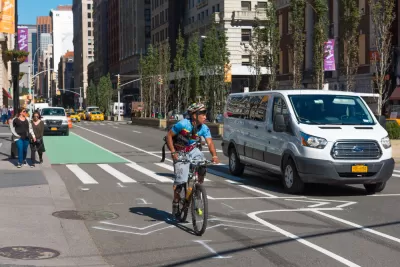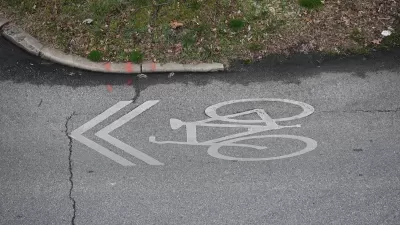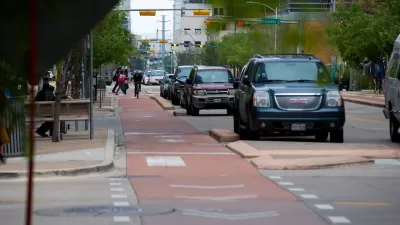Some research suggests that separated and even ‘protected’ bike lanes actually increase the likelihood of car-bike collisions.

After a U.S. State Department foreign service officer died after being hit by a vehicle while riding her bicycle, Diana Furchtgott-Roth of Forbes poses the argument that painted and protected bike lanes could actually raise the risk of crashes.
“The National Highway Traffic Safety Administration estimates that 938 cyclists were killed on the roads in 2020, the latest available data. That’s up by 9 percent from 2019 and the highest number since 1987,” Furchtgott-Roth writes, arguing that bike lanes are “not a safe space” for people on bikes because “it’s impossible to structure bike lanes without vehicles turning into these lanes to get to underground garages, above-ground parking lots, and to make right or left turns at intersections.”
Furchtgott-Roth points to a paradox “originally described by industrial engineer John Forester in his 800-page book Effective Cycling, which boasted seven editions (MIT Press, 2012),” which states that protected bike lanes are more dangerous than shared normal roads. Forester “forecast more car-bike collisions, because it is difficult to make intersections between cycle lanes and roads as safe as normal roads.”
Other studies also find that bike lanes increase the chance of crashes compared to shared roadways. One Colorado study “concluded that separated bike lanes raise the number of crashes by 117 percent compared with shared roadway.” Jan Heine, editor-in-chief of Bicycle Quarterly, wrote “On streets with frequent intersections, separate paths only make cycling less safe.”
According to the article, “In many urban settings the safest place for a bike is in the middle of a car lane, with bike lights and a helmet lamp for the rider, cycling behind vehicles rather than beside them.” This must be coupled, of course, with robust driver education that, essentially, changes America’s driving culture toward an ethos of sharing the road. “All states need to educate drivers, as part of driving tests, to treat cyclists respectfully, just as they treat other vehicles respectfully.”
FULL STORY: Bike Lanes Don’t Make Cycling Safe

Alabama: Trump Terminates Settlements for Black Communities Harmed By Raw Sewage
Trump deemed the landmark civil rights agreement “illegal DEI and environmental justice policy.”

Study: Maui’s Plan to Convert Vacation Rentals to Long-Term Housing Could Cause Nearly $1 Billion Economic Loss
The plan would reduce visitor accommodation by 25% resulting in 1,900 jobs lost.

Planetizen Federal Action Tracker
A weekly monitor of how Trump’s orders and actions are impacting planners and planning in America.

Wind Energy on the Rise Despite Federal Policy Reversal
The Trump administration is revoking federal support for renewable energy, but demand for new projects continues unabated.

Passengers Flock to Caltrain After Electrification
The new electric trains are running faster and more reliably, leading to strong ridership growth on the Bay Area rail system.

Texas Churches Rally Behind ‘Yes in God’s Back Yard’ Legislation
Religious leaders want the state to reduce zoning regulations to streamline leasing church-owned land to housing developers.
Urban Design for Planners 1: Software Tools
This six-course series explores essential urban design concepts using open source software and equips planners with the tools they need to participate fully in the urban design process.
Planning for Universal Design
Learn the tools for implementing Universal Design in planning regulations.
Caltrans
Smith Gee Studio
Institute for Housing and Urban Development Studies (IHS)
City of Grandview
Harvard GSD Executive Education
Toledo-Lucas County Plan Commissions
Salt Lake City
NYU Wagner Graduate School of Public Service





























